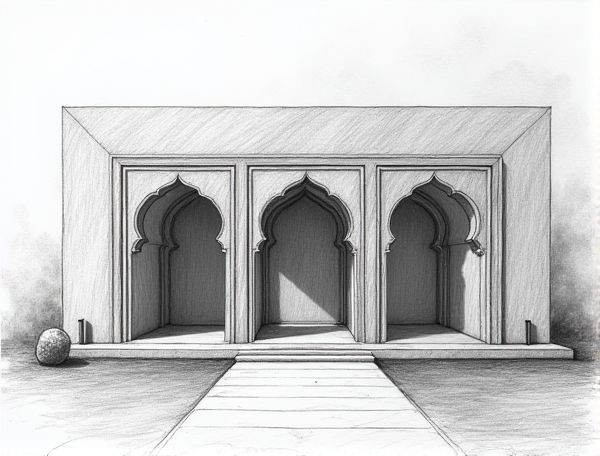
Photo illustration: Islamic geometric home design with mashrabiya screens
Incorporating Islamic geometric patterns and mashrabiya screens into your home design adds both aesthetic beauty and functional privacy while promoting natural airflow and light diffusion. Discover how these intricate designs can transform your living space by reading more in the article.
Introduction to Islamic Geometric Home Design
Islamic geometric home design integrates intricate patterns rooted in centuries-old mathematical principles, enhancing the aesthetic and spiritual ambiance of your living spaces. These designs typically feature symmetrical shapes such as octagons, stars, and tessellations, creating harmonious and culturally resonant environments.
Origins and History of Mashrabiya Screens
Mashrabiya screens originated in the medieval Islamic world, primarily between the 10th and 15th centuries, serving as intricate wooden latticework used in residential architecture across the Middle East and North Africa. These screens provided privacy, ventilation, and shade, allowing cool air to flow while obscuring interior views, reflecting cultural values and innovative climate adaptation. You can incorporate mashrabiya elements into your home design to evoke historical authenticity and enhance natural airflow in warm climates.
Key Elements of Islamic Geometric Patterns
Islamic geometric patterns in home design feature intricate symmetry, repetitive motifs, and alternating shapes like stars, hexagons, and rosettes, emphasizing balance and infinite continuity. Your space can be enriched by incorporating these patterns through tile work, wood carvings, and stained glass, reflecting cultural heritage and spiritual symbolism.
Benefits of Integrating Mashrabiya in Modern Homes
Integrating mashrabiya in modern homes enhances natural ventilation while maintaining privacy, reducing the need for artificial cooling and lowering energy costs. The intricate lattice design filters sunlight, creating dynamic patterns and reducing glare without blocking views. Elevate your home's aesthetic and sustainability by incorporating this traditional architectural element that harmonizes elegance with eco-conscious living.
Materials and Techniques for Crafting Mashrabiya
Mashrabiya construction primarily involves intricately carved hardwoods such as teak, mahogany, or walnut, chosen for their durability and ability to hold fine details. Traditional woodworking techniques like mortise-and-tenon joinery, hand carving, and lattice weaving ensure structural integrity while allowing complex geometric patterns. Modern adaptations sometimes incorporate fiberglass or metal frameworks to enhance longevity and reduce maintenance without compromising the aesthetic intricacy.
Mashrabiya in Interior vs. Exterior Applications
Mashrabiya enhances interior spaces by providing filtered natural light and privacy while maintaining airflow, ideal for creating tranquil, shaded environments in living rooms and bedrooms. On exteriors, mashrabiya serves as an architectural element that reduces solar heat gain, contributing to energy efficiency and adding intricate cultural aesthetics to facades. Its versatile design integrates traditional craftsmanship with modern functionality, optimizing comfort and style in both interior and exterior home applications.
Enhancing Privacy and Light with Geometric Screens
Geometric screens enhance home design by providing a stylish solution that balances privacy and natural light flow. These patterned installations create distinct zones while allowing sunlight to filter through, reducing the need for heavy curtains or blinds. Using materials like wood or metal, geometric screens offer durability and aesthetic appeal, contributing to a modern and functional living space.
Combining Traditional Mashrabiya with Contemporary Decor
Integrating traditional Mashrabiya screens into contemporary decor enhances your home's aesthetic by blending intricate, geometric wooden latticework with sleek, modern materials, creating a harmonious balance of privacy and natural light. This fusion preserves cultural heritage while adding depth and texture, making your living space both visually striking and functionally elegant.
Maintenance and Care of Islamic Geometric Features
Regular cleaning with a soft, dry cloth preserves the intricate patterns of Islamic geometric designs, preventing dust accumulation and surface damage. Applying a gentle, pH-neutral cleaner occasionally maintains the vibrancy of colors and materials while avoiding harsh chemicals that can erode delicate details.
Inspiring Mashrabiya Design Ideas for Every Room
Mashrabiya designs enhance home interiors with intricate wooden latticework that provides privacy while allowing natural light and airflow. Incorporating these traditional patterns in living rooms, bedrooms, and kitchens creates an elegant fusion of cultural heritage and modern functionality.
 homedesy.com
homedesy.com